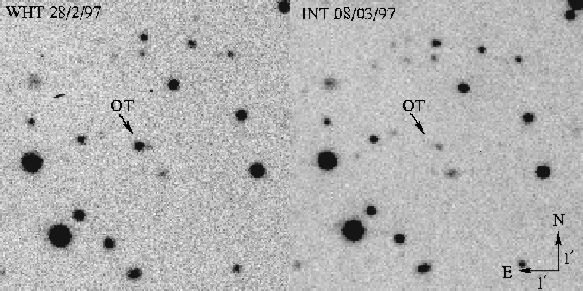
|
Credit & Copyright: P. J. Groot (U. Amsterdam)
et al., WHT, INT
Explanation:
The largest telescopes in the world have scrambled
to point toward this faint, fading object.
Why? Because it may well be the first active optical counterpart
ever found for a gamma-ray burst,
and could hold the clue to the distance scale to this most
enigmatic class of astronomical objects.
During the past two months, multiwavelength observations,
claims,
and counterclaims
have been exchanged at a torrential pace, as astronomers wait impatiently
to see what setting houses the
fading transient.
Above are two pictures of the optical transient
(OT), one taken on February 28th, the other about a
week later on March 8th. The OT arrows show the source
that faded from view during this time.
The OT
has been examined by large telescopes including the Hubble
Space Telescope
and Keck, yet researchers are still scrambling
to get answers to fundamental questions about its true nature.
Does the OT
actually move (exhibit
proper motion)?
Is there a faint galaxy superposed behind
the OT or is this extended emission fading too?
In the face of intense scrutiny with the world's most capable telescopes,
the origin of gamma-ray bursts so far remains mysterious!
|
January February March April May June July August September October November December |
| ||||||||||||||||||||||||||||||||||||||||||||||||
NASA Web Site Statements, Warnings, and Disclaimers
NASA Official: Jay Norris. Specific rights apply.
A service of: LHEA at NASA / GSFC
& Michigan Tech. U.
Based on Astronomy Picture
Of the Day
